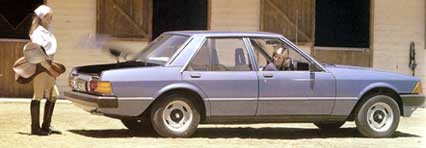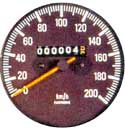
| Ford XD Falcon | |||||||
| On Sale: March 1979 - March 1982 (XD 1/2: June 1980) | |||||||
| How do I know it's an XD? New square shaped European body, with square headlights, Ford badge in centre of black grille, metal door handles | |||||||
|
|||||||
|
|||||||
| What’s new? Lots of plastic instead of steel, alloy head (XD 1/2) | |||||||
| Falcon Firsts: Plastic bumpers, plastic fuel tank: a world first, standard rear wiper on wagon. | |||||||
| Prices at introduction: Falcon GL sedan - $6600, Fairmont Ghia sedan - $9558 | |||||||
| Total XDs built: 206974 | |||||||
| Transmission: 3 speed manual, 4 speed manual, 3 speed automatic | |||||||
| Engines: 3.3L 6 cyl Bore and stroke: 93 x 80 mm Power: 82kW at 4000rpm Torque: 228Nm at 2400rpm Pushrod overhead valve, 2 valves per cylinder Fuel system: Bendix single-barrel carburettor Compression ratio: 8.8:1 |
4.1L
6 cyl Bore and stroke: 93 x 99 mm Power: 94kW at 3600rpm Torque: 295Nm at 1800rpm Pushrod overhead valve, 2 valves per cylinder Fuel system: Bendix single-barrel carburettor Compression ratio: 9.0:1 |
||||||
| 4.9L
V8 Bore and stroke: 102 x 76 mm Power: 140kW at 4500rpm Torque: 344Nm at 3200rpm Pushrod overhead valve, 2 valves per cylinder Fuel system: Carter four barrel carburettor Compression ratio: 9.2:1 |
5.8L
V8 Bore and stroke: 102 x 89 mm Power: 149kW at 4300rpm Torque: 415Nm at 3000rpm Pushrod overhead valve, 2 valves per cylinder Fuel system: Carter four barrel carburettor Compression ratio: 8.9:1 |
||||||
| 3.3L
Alloy Head 6 cyl Bore and stroke: 93 x 80 mm Power: 84kW at 4000rpm Torque: 230Nm at 2400rpm Pushrod overhead valve, 2 valves per cylinder Fuel system: Bendix single-barrel carburettor Compression ratio: 9.15:1 |
4.1L
Alloy Head 6 cyl Bore and stroke: 93 x 99 mm Power: 94kW at 3600rpm Torque: 305Nm at 2000rpm Pushrod overhead valve, 2 valves per cylinder Fuel system: Bendix single-barrel carburettor Compression ratio: 9.35:1 |
||||||
| Fuel consumption: AS2077 City/Highway per 100km: 13.5L/9.5L (Falcon GL 3.3, 3 speed auto) | |||||||
| Performance: (Falcon 4.1L sedan, three speed auto): Top speeds in gears 1st: 90km/h 2nd: 138km/h 3rd: 175km/h 0-100km/h: 13 seconds Standing 400m: 18.5 seconds |
(Falcon 5.8L V8 sedan, four speed manual): Top speeds in gears 1st: 80km/h 2nd: 110km/h 3rd: 150km/h 4th: 207km/h 0-100km/h: 8.6 seconds Standing 400m: 16.1 seconds |
||||||
| Suspension: Front Fully independent. Double wishbone with brake reaction strut in tension. Spring and shock absorber mounted on upper arm. Anti-roll bar. Dual durometer brake reaction strut bush |
Rear Floating axle. Hotchkiss rear suspension. Inclined shock absorber units. Anti-roll bar (sedan only) |
||||||
| Brakes: Front Ventilated disc 286 x 24mm single piston, self-adjusting floating caliper |
Rear GL and Fairmont - 254 x 44mm self-adjusting duo servo drums, Fairmont Ghia - ventilated disc 286 x 24mm single piston, self-adjusting floating caliper |
||||||
| Steering: Manual: recirculating ball, 5.2 turns lock-to-lock, Power: recirculating ball, hydraulically assisted, 2.6 turns lock-to-lock | |||||||
| Wheels: 5.50 x 14 steel, 6.00 x 14 steel, 6.00 x 14 alloy, 7.00 x 15 alloy | |||||||
| Tyres: Steel belted radials: Falcon GL 3.3/4.1: CR78 S14 4-ply, optional ER78 S14 4 ply, ER70 H14 6 ply. Fairmont 4.1 sedan, GL/Fairmont 3.3/4.1 wagon: ER78 S14 4 ply 6 inch rims, optional ER70 H14 6 inch rims. GL/Fairmont V8, Ghia sedan: ER70 H14 6 ply 6 inch rims. | |||||||
Dimensions:
|
Interior
dimensions:
|
||||||
| Features: | |||||||
| Awards: | |||||||
| Rivals: Holden VB/VC/VH Commodore, CM Valiant | |||||||
| XD Falcon Links (new window) | Related pages | ||||||
The
Ford Falcon XD 6cyl Page |
Falcon
Facts: ZJ Fairlane / FC LTD Falcon Facts: XC Falcon Falcon Facts: XE Falcon |
||||||
| Where to now? Back to Falcon main On to XE Falcon» | |||||||




